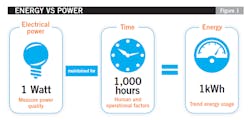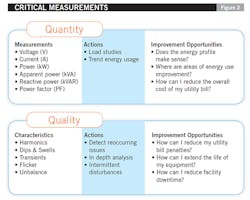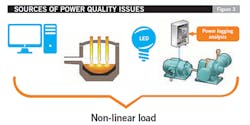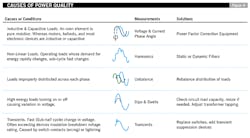There are several reasons why power quality and energy use monitoring may not be part of your facility’s overall schedule. Adding one more thing to a growing list of important maintenance tasks needing to be done now may seem impossible. Additionally, limited resources in terms of time and staff as well as the never-ending pursuit of keeping machinery up and running can make it difficult to stop and take stock of even your present monitoring activities. You may be afraid of what you’ll find, too – and if you do find something, then what?
Here, we’ll give you the basics and benefits of implementing power quality and energy monitoring and answer these questions.
- Why should I care about power quality and energy?
- What is energy?
- What is power?
- What happens if I do nothing about a power quality issue?
- Where should I take power measurements?
- What do I do with the data?
Why should I care about power quality and energy?
Energy and power go together, and you can’t fully manage your facility without logging energy use and troubleshooting power quality issues. More to the point—you can’t manage what you can’t measure.
Many companies monitor the cost of oil and gas, but smart companies also pay attention to the quality of their power and to their energy bills. By measuring energy and power quality, you’ll begin to get a feel for your plant’s rhythm, and instead of flying blind and constantly putting out fires, you’ll learn how to use the knowledge to keep your plant running smoothly and efficiently.
What's the difference between energy and power?
The words “energy” and “power” often are used interchangeably; however, it’s not accurate to do so. To be exact, one watt of electrical power maintained for a thousand hours equals one kilowatt hour of energy (see Figure 1). Put another way, energy is the capacity to do work, whereas power is the rate at which work is done.
Usually when you measure power, it’s to measure quality, and factors such as time, human behaviors, and operations can have an impact on power quality. Examples:
Human factors – how long are lights being left on; are windows and doors being left open, letting hot air in or cool air out?
Operational factors – how fast am I pumping this liquid; how much air needs to go through the air handler?
When we talk about energy, we’re talking about the capacity to do work. In physics terms, energy is what makes it possible to move objects. Whether moving an electron down a wire or a car down the road, work is being done. If you know the strength of force needed to move the object and you know how far it will move, then you can calculate the energy needed. When you measure energy, you typically track it as well as trend it – building a repository of valuable historical data in the process. You can do the same with power; you can track and trend it.
Quantity and quality
When you want to measure quantity, you measure the voltage, current, power, and power factor. Typical actions associated with quantifying data are performing load studies to figure out if it is possible to add more machines to your facility.
Quality is associated with characteristics such as harmonics; dips and swells; transients; flicker; and unbalance (see Figure 2).
Troubleshooting or detecting recurring issues such as tripping breakers and performing in-depth analysis to find intermittent disturbances are the actions related to quality. One of the many reasons to take the actions to improve your power quality is to reduce utility penalties or completely avoid them. When you have a poor power factor, a utility company can charge you a fee, depending on your contract.
Poor power factor means you’re putting poor power back on to the utility grid and are using your power inefficiently. The utility company will charge you not only for the time during which you had poor power factor, but for the entire billing period.
Power quality issues are becoming more prevalent, and one common source comes from LED lighting (see Figure 3). Unfortunately, energy-saving additions such as LEDs can cause harmonics issues. Additionally, circuit breaker trips and blown fuses, as well as the overheating of machines, transformers, and motors also affect your facility’s overall system power health and the life of your machinery.
When considering what monitoring tools to have on hand, you’ll want to decide exactly what you want the tool to do. Do you need the tool to measure just one thing, or do you need a tool with broader capabilities?
For instance, a multiuse tool may calculate energy loss and capture three-phase high resolution voltage and current waveforms, while another tool can provide immediate power quality health data. It just depends on the specific needs of your facility.
Common causes of energy waste
Common causes of energy waste include human and process inefficiencies, operating loads, worn or faulty loads, and poor power quality. When it comes to addressing energy waste due to aging motors or incorrectly sized motors in particular, there are tools that can perform an electrical power analysis on an aging motor or measure motor mechanical power torque and efficiency, so you can size your motor according to NEMA rating guidelines.
Operating loads that exceed the utility peak demand rate mean you potentially incur a surcharge on your utility bill. To avoid exceeding peak demand rates, perform energy studies and trend your facility’s power use. You’ll be able to figure out the right-level load for your process or decide whether you can move production to another shift that has lower peak hours.
Power quality issues
Power quality is affected by many factors. Figure 4 lists causes of and types of power quality issues and the actions you can take to improve them. One of the primary ways to improve a power quality issue is to correct a harmonics problem.\
Poor power quality can result from nonlinear loads such as LED light bulbs, motor drives, and electric arc furnaces. Harmonics in power systems can cause overheating of equipment, wires, and cables, misfiring of variable-speed drives, etc.
Harmonics can influence the power factor and inadvertently cause a surcharge on your utility bill. Discovering harmonics requires a power quality test instrument. Designing a harmonic filter or installing power-factor correction circuits will minimize the effects of harmonics and improve the power factor.
Having an electrically unbalanced load – the result of, for example, having reactive single-phase loads – also can create power quality issues. An unbalanced load can cause overheating of electrical components. Having reactive single-phase loads like welders or unequal impedance in conductors of power supply wiring are examples of what can cause unbalance issues.
There are different types of transients: impulsive and oscillatory. Lightning produces impulsive transients – impulsive because a lightning strike results in a quick change to the power system. A switching capacitor, by contrast, is categorized as an oscillatory transient because it has not only a spike but also ringing of the voltage. Transients can be mitigated by installing a properly sized transient suppressor.
Where should you take power measurements?
Within a facility, there are many places you can measure power quality and energy. There are essentially three subsystems you can analyze: 1) production process systems, 2) building infrastructure, and 3) electrical systems.
Han Tran is a product application specialist for Fluke Corp. She has an M.S. in electrical and computer engineering from Georgia Institute of Technology. Previously, she worked for Bently Nevada, a General Electric company, as an electrical engineer. In this role, she worked on embedded systems for Bently’s condition monitoring solutions. As a specialist, Tran has been collaborating with end users to understand the pain points they experience on the job and to develop solutions for these end users.
Your decisions about where to take three-phase electrical power measurements will depend on what you think you know and where you think the problem lies. Let’s look at three possible scenarios.
Scenarios 1 and 2 - What’s the problem and where do I start?
You don’t know what the cause of the problem is, but you decide to measure power in case that’s the issue. Or, you suspect you have a power quality issue, but you don’t know where to start.
The best practice would be to start at the load and move upstream toward the main service entrance. If the facility is large and has too many loads to pick from, starting at the main service entrance and then working your way downstream is perfectly acceptable. By doing so, you gain an overall reading on how your building’s energy and power is acting. In this scenario, you start at the main service entrance and move downstream to what you think is the problem. For example, your next measurement after the main service entrance could be the load bank leading to the disconnect of Motor #1. If you determine the circuit branch at Motor #1 is not the issue, your next step would be to go down a different circuit branch and keep going until you identify the issue.
When you don’t know what the problem is, it is helpful to have tools that can help you identify and then summarize all your power quality issues on one dashboard. The ease of setup is also important, and being able to pull the data from the instrument quickly is essential. Once you know where and what the problem is, you can solve the problem.
You can also use tools to exclude problems. For instance, if your tool shows you have a harmonics issue, you’ll know to focus on causes for harmonics, such as a nonlinear load. Now you can send your maintenance team to figure out what specific equipment is creating the harmonics and deploy a solution.
Scenario 3 – I think it’s the motor, now what?
Start again at the main service entrance. Once you find that it’s a power quality issue and you believe it’s Motor #1, you can use a tool to get more information.
Some power quality measurement tools can provide mechanical information, such as torque or motor efficiency, in addition to power quality and energy analysis. This information can help you identify whether a motor is improperly sized. A motor that’s too big wastes money; one that’s too small will burn out faster.
Other scenarios and recommendations
An alternative to using handheld tools to measure each part of a circuit is to use a three-phase power quality logger. The logger stays in place and is controlled and viewed from a computer, while a separate “module” is taken to the different parts of the circuit. Together the logger and modules provide an overall picture of what energy is being consumed and power quality issues. This is a way to log comprehensive information at your main feed while also collecting power quality health information and energy consumption at each load.
Monitoring your power quality and energy usage has many benefits, including reducing downtime and your utility bill. By taking measurements and using tools to understand your plant’s overall heartbeat and rhythms, you’ll more easily recognize abnormalities and increase opportunities to address them before it’s too late.




